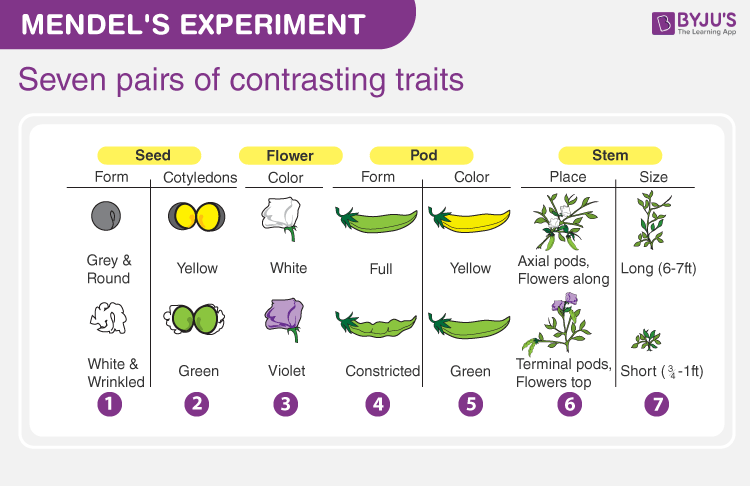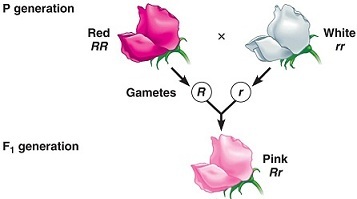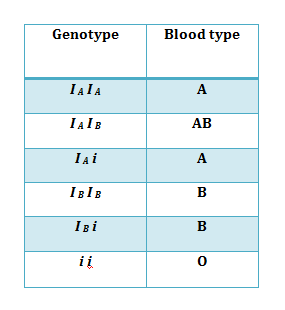Find below the important notes for the chapter, Principles of Inheritance and Variation as per the NEET Biology syllabus. This is helpful for aspirants of NEET and other exams during last-minute revision. Important notes for NEET Biology- Principles of Inheritance and Variation cover all the important topics and concepts useful for the exam. Check BYJU’S for the full set of important notes and study material for NEET Biology and solve the NEET Biology MCQs to check your understanding of the subject.
Download Complete Chapter Notes of Principles of Inheritance and Variation
Download Now
Table of Content:
- Mendels Laws of Inheritance
- Incomplete Dominance
- Chromosomal Theory of Inheritance
- Sex Determination
- Mutation
- Genetic-Disorders
| Name of the NEET sub-section | Topic | Notes helpful for |
| Biology | Principles of Inheritance and Variation | NEET exams |
Principles of Inheritance and Variation – Important Points, Summary, Revision, Highlights
Principles of Inheritance and Variation
Heredity is a process of transmission of heritable traits from parents to their offsprings.
Genetics is the branch of biology dealing with the principles and mechanism of inheritance and variation.
Inheritance is the basis of heredity and by this process, traits are passed on from the parents to the offsprings. Continuity of the gene pool is maintained by the process of inheritance.
Genes are the basic unit of inheritance and located on chromosomes.
Variation exists among individuals of one species. Variation is due to crossing over, recombination, mutation and environmental effects on the expression of genes present on chromosomes.
| Don’t miss: All NEET Question papers |
Mendel’s Laws of Inheritance
Gregor Johann Mendel is called “Father of genetics”.
Mendel performed experiments on Garden pea. He took 14 true-breeding plants of pea having seven distinguishable characters, which have two opposite traits.
He called genes as “factors”, which are passed from parents to offsprings.
Genes, that code for a pair of opposite traits are called “alleles”.

He gave three laws of inheritance based on his observation:
-
- Law of Dominance: One of the alleles is dominant and gets expressed in the phenotype in case of the heterozygote, e.g. When we cross homozygous tall (TT) and dwarf (tt) plants, in the offsprings we get all the tall plants having the genotype Tt, so tallness is a dominant trait over dwarfness.
- Law of Segregation of genes: Each allele separates during meiosis at the time of gamete formation. There is no blending and characters are passed to different gametes. Homozygotes produce only one kind of gametes and heterozygotes produce different kinds of gametes.
You may like: NEET Key Answer 2022

- Law of Independent assortment: It states that alleles for different traits are inherited independently. He showed that using a dihybrid cross.

Test Cross: It is to find out the genotype of the plant showing dominant trait, the given plant is crossed with the recessive homozygote. The two observations are:
- If the phenotype of offsprings shows only the dominant trait, then the parent plant was homozygote to the dominant trait
- If the offsprings produced are of both phenotypes, then the parent plant was heterozygote to the dominant trait.
Incomplete Dominance
- When neither of the two alleles is dominant and the phenotype of the heterozygote does not resemble any of the parents. The heterozygote expresses intermediate or a mixture of two parents’ traits
- Example: The flower colour inheritance of snapdragon (dog flower). On crossing true breeding red (RR) and white flower (rr), we get all pink colour flowers in the F1 generation, which on self-pollination give red: pink: white flowers in the ratio 1:2:1 in the F2 generation

Co-dominance
- When both the alleles express themselves together in an individual, they are said to be co-dominant
- Example: The inheritance of the ABO blood group in humans is controlled by the gene I. The gene I has three allelic forms, IA, IB and i. In a human being, any two out of three alleles are presentIA and IB code for different kinds of sugar polymers present on the surface of RBC and ‘i’ does not produce any sugarIA and IB are dominant over ‘i’, but IA and IB are co-dominant and express themselves together.

Chromosomal Theory of Inheritance
- Sutton and Boveri supported Mendel’s observations and stated that chromosomes are the carrier of genes
- Chromosomes occur as a homologous pair and the two alleles of a gene are located on the homologous pair of chromosomes at the same site
- Homologous chromosomes separate during meiosis in the process of gamete formation
- Chromosomes segregate and assort independently
- During fertilization, gametes combine and produce the offsprings with the diploid no. of chromosomes, that is similar to the parent
- Morgan extensively worked on fruit flies, Drosophila melanogaster and provided experimental evidence to support the chromosomal theory of inheritance
Linkage and Recombination
- Physical association of genes located on a chromosome is known as linkage
- In a dihybrid cross, if the two genes are tightly linked or present on the same chromosome, the parental combination is more prevalent than non-parental combinations or recombinants
- The linkage and recombination are directly dependent on the distance between a pair of genes. More the distance, greater is the probability of recombination
Multiple alleles- When a trait is governed by more than two alleles, e.g. ABO blood group.
Polygenic Inheritance- When a trait is governed by multiple independent genes, that have a similar or additive effect on the trait, it is known as polygenic inheritance, e.g. eye colour, skin pigmentation, height, hair colour, etc.
Polygenic inheritance is also affected by environmental conditions.
Pleiotropy- When a single gene controls many phenotypic traits, it is known as a pleiotropic gene. The different phenotypic expressions are mostly a result of the effect of a gene on metabolic pathways.
E.g. a single gene mutation in the gene coding for the enzyme phenylalanine hydroxylase results in the disease known as phenylketonuria, which is characterised by mental retardation, reduced hair and skin pigmentation.
Sex Determination
- There are different systems of sex determination present in different organisms.
- Henking first observed X chromosome and named it X body.
- The chromosomes that determine the development of sexual characters are known as sex chromosomes and the rest of the chromosomes are known as autosomes.
- When the male produces two different kinds of gamete, it is known as male heterogamety, e.g. humans, grasshoppers, drosophila, etc.
- When the female produces two different kinds of gamete, it is known as female heterogamety, e.g. birds.
| Sex determination in different animals | ||
| Name | Male | Female |
| Human | XY | XX |
| Drosophila | XY | XX |
| Grasshopper (insects) | XO | XX |
| Birds | ZZ | ZW |
Sex determination in the honey bee:
- Haplo-diploid sex-determination system
- Female (queen or worker) is formed by the fusion of an egg and sperm and have diploid (32) no. of chromosomes
- Male (drone) is formed from an unfertilized egg by parthenogenesis and have haploid (16) no. of chromosomes. Sperms are produced by mitosis
Mutation
- Any changes in the sequence of DNA is called a mutation. Viable mutations get inherited from one generation to another. A mutation changes the genotype as well as the phenotype of an organism
- It is linked to various diseases, but not all mutations are harmful
- Changes like, deletion, insertion, duplication, substitution, etc. result in mutation. A mutation is the major cause of cancer. There are many mutation inducing agents (mutagens) such as UV rays
- There are two types of genetic mutation:
- Point mutation: There is a substitution in the single base pair of DNA, e.g. in the sickle cell anaemia. The 6th codon of the gene coding for the 𝛃-globin chain of haemoglobin changes from GAG to GUG, resulting in the substitution of glutamic acid by Valine.
- Frameshift mutation: It results from the insertion or deletion of one or more pairs of bases in DNA. it changes the reading frame of triplet codons, that code for certain amino acids of the protein.
Genetic Disorders
There are many disorders in the human being that are inherited and caused due to mutation in the gene or alteration in chromosomes.
Pedigree Analysis helps in determining the risk of getting a genetic disorder in the offsprings by studying the inheritance pattern of a particular trait present in various generations of an individual.
Genetic disorders can be grouped into two types:
1. Mendelian Disorders
- These are disorders due to alteration in the single gene
- It follows the same inheritance pattern, as per Mendel’s law
- Pedigree analysis can help trace the inheritance pattern and also determine if the trait is dominant or recessive
| Mendelian Disorders | ||||
| Name | Genetic Trait | Cause | Effects | Inheritance pattern |
| Colour blindness | X-linked recessive | Defect in the green or red cone of the eye | Unable to discriminate between red and green colour | A daughter will be colour blind only if the father is colour blind
There is a 50 percent probability of a carrier female to transfer the disease to sons |
| Haemophilia | X-linked recessive | Defect in one protein involved in the clotting of blood | Continuous bleeding from wounds | A daughter will be colour blind only if the father is colour blind
There is a 50 percent probability of a carrier female to transfer the disease to sons |
| Sickle cell anaemia | Autosome-linked recessive | A single point mutation in the beta-globin chain of haemoglobin | Anaemia | Offsprings may get the disease when both the parents are a carrier (heterozygote) |
| Thalassemia | Autosome-linked recessive | Mutation in the genes HBA1 and HBA2 present on the chromosome 16 | Formation of abnormal haemoglobin molecule resulting in anaemia | Offsprings may get the disease when both the parents are a carrier (heterozygote) |
| Phenylketonuria | Autosome-linked recessive | Lack of an enzyme that converts phenylalanine to tyrosine | Mental retardation. Accumulation and excretion of phenylalanine and its derivatives in urine | Offsprings may get the disease when both the parents are a carrier (heterozygote) |
2. Chromosomal Disorders
- These are disorders due to excess, absence or abnormal arrangement of chromosomes
- Chromosomal disorders are of two types:
(i) Aneuploidy- Gain or loss of one or more chromosomes. It is due to failure of segregation of chromatids during anaphase of meiosis
(ii) Polyploidy- It is often found in plants. This happens due to an increase in the full set of chromosomes. Failure of cytokinesis results in polyploidy - Some examples of chromosomal disorders:
Down’s syndrome- Trisomy of chromosome 21. Symptoms include mental retardation, short stature, furrowed tongue, partially opened mouth
Klinefelter’s syndrome- Total 47 chromosomes with one extra X chromosome, i.e. XXY, They are sterile, tall, overall masculine with feminine characteristics such as breast development (gynecomastia)
Turner’s syndrome- Total 45 chromosomes. One X chromosome is missing, i.e. XO. females are sterile, short stature and under-developed sexual characters
Click here to know more about chromosomal disorders in humans.
Explore the next chapter for important points with regards to the NEET exam, only at BYJU’S. Check the NEET Study Material for all the important concepts and related topics.
Recommended Videos:



Also see:
NEET Flashcards: Principles Of Inheritance And Variation
NEET Flashcards: Molecular Basis Of Inheritance
NEET Flashcards: Cell Cycle And Cell Division
Download The PDFs for Daily Practice Problems and Worksheet for Principles of Inheritance and Variation
Daily Practice Problems:-Download PDF Here
Worksheet:-Download PDF Here
It is very useful app 👍
It’s very useful 👍 thank you.
This was really helpful hope you guys keep posting study articles like this
I need neet materials
Please check the study material for NEET here.
Can I get the pdf of this chapter